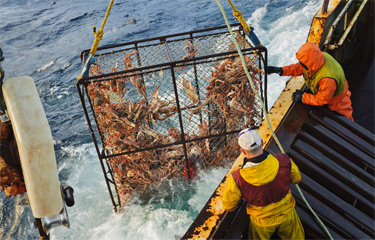An unexpected and precipitous drop in the estimated biomass for Alaska snow crab has resulted in an official “overfished” designation.
The designation, made retroactive to 19 October, 2021, was in response to the the 2021 stock assessment, which was presented to the North Pacific Fishery Management Council in October and reported that the minimum threshold for the biomass of mature male opilios is 76,700 metric tons, and the most recent assessment estimated it at 50,600 metric tons – a historic low.
“A large year-class recruited to the survey gear in 2015 and was tracked until 2018 and 2019,” the assessment report said. “But it appears to have since disappeared from the eastern Bering Sea shelf before reaching commercial size.”
With an 88 percent cut in this year’s quota, Alaska’s crab fleet is bracing for the onset of a rebuilding plan. The Magnuson-Stevens Act requires a rebuilding plan to be implemented within two years of a fishery being declared overfished.
“What we do know is that snow crab is a variable stock where highs and lows are not unexpected. What is different is the magnitude of the high and quickly falling to a historic low,” Alaska Bering Sea Crabbers Executive Director Jamie Goen told National Fisherman. “We’re hopeful seeing some crab out there this season and look forward to working with the federal and state managers through the rebuilding plan process to help bring snow crab stocks back to higher levels.”
Given that the overfished status is based on a significant drop in estimated crab biomass from 2020 to 2021 after years of tracking a strong 2015 year-class coming into maturity, the council’s scientific and statistical committee and the crab plan team are seeking more answers about the methodology and modeling used to establish the biomass estimates. One of the regulators’ questions is whether that disappearance is partially attributable to a modeling flaw compounded by the lack of data from the 2020 summer survey, which was canceled because of the pandemic.
“The CPT is scheduled to review the stock assessment model during [its] May meeting, and the SSC will then review it in June 2022,” a Snow Crab Rebuilding Progress Report, published in mid-January, said. “As a result, many of the model outputs presented at the January 2022 CPT meeting may change, given the range of considerations that the CPT asked the author to address.”
In the meantime, the stock assessment model has yet to be approved by the council’s scientific and statistical committee for use in management.
The process has also left fishermen confused and concerned, according to Goen. The Bering Sea fleet is in the peak of opilio season, and they’re finding some pockets of crab.
“While less than half the fleet are fishing this year due to historic low quotas, reports from skippers are that fishing is ranging from average to below average with the patches of crab being smaller than normal,” Goen told National Fisherman.
Fishermen are also coping with the state’s closure of the Bristol Bay red king crab fishery for the first time in 25 years, as well as a 53 percent cut to bairdi quotas.
Goen said she estimated the closures and cuts could cost the crab fleet USD 234 million (EUR 204 million) in ex-vessel value.
“As the third-highest-value fishery to the state of Alaska behind salmon and pollock, we want to help bring crab stocks back for the state of Alaska, for our small, independent fishermen, and for the communities that depend on this fishery,” Goen said.
Speculation about the disappearance of the crab has also led to questions about bycatch in other fisheries, specifically groundfish trawling.
The crab plan team’s February report noted that curtailing crab bycatch from another fishery would require additional regulations, and likely more time to establish the plan.
“If associated regulations that affect other fisheries (i.e. groundfish) are necessary, additional implementation of regulations would be required,” the Snow Crab Rebuilding Progress Report said.
The next North Pacific Fishery Management Council meeting begins Monday, 7 February. The next step for the snow crab managers is to select alternatives for the rebuilding plan, now scheduled for the June council meeting.
Reporting by Jes Hathaway
Photo courtesy of ASMI/Chris Miller







